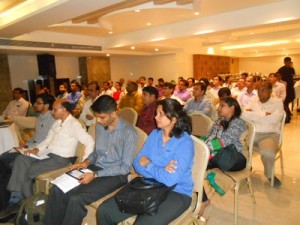The Goods and Services Tax (GST) is one of the most discussed topics amongst business owners, industrialists, organisational  leadership teams, chartered accountants, lawyers and students of management and economics. Touted as the biggest tax reform of independent India, the new indirect tax regime is on its way to become a reality starting 1st April 2017. The final rollout of the GST bill will have a significant impact on every business and consumer, in the new, unified national common market that India is poised to become. In this regard, Trade Association of Information Technology (TAIT) organised a workshop for its members to appraise them on the impact of GST on the India’s indirect tax structure for IT, Telecommunications and Electronics products, solutions and services.
leadership teams, chartered accountants, lawyers and students of management and economics. Touted as the biggest tax reform of independent India, the new indirect tax regime is on its way to become a reality starting 1st April 2017. The final rollout of the GST bill will have a significant impact on every business and consumer, in the new, unified national common market that India is poised to become. In this regard, Trade Association of Information Technology (TAIT) organised a workshop for its members to appraise them on the impact of GST on the India’s indirect tax structure for IT, Telecommunications and Electronics products, solutions and services.
Mr Rajeev G. Varaiya, Partner, Damania & Varaiya briefed TAIT members on the various nuances related to GST. He spoke at length about the present taxation structure in India, global adoption of GST, India’s Model GST Law, GST compliance and reporting norms, taxes to be subsumed into GST and exclusions from GST. Talking about the benefits of GST and its positive impact on the IT industry he said, “The landmark GST bill passed in the Monsoon Session of Parliament is expected to simplify indirect taxation, roll out single and uniform GST rates across the country, with a transparent tax structure. It will create a seamless tax credit mechanism across the business value chain. The GST legislation will improve competitiveness of Indian industry as the cascading effect on input costs and cost of compliance are expected to fall significantly. IT service providers will be able to set-off input GST on the purchase of goods required to set up IT infrastructure, against their output liabilities, even as the cascading effect of multiple taxes decreases.”
GST being a destination based tax is widely expected to smooth conduct of business in the country with faster movement of goods, easy and unified compliance by reducing classification hassles, and avoid distortions due to multiplicity of levies and exemptions. It will increase market buoyancy and help to expand the organised sector.
Mr. Varaiya also explained various situations where a tax refund would arise – excess payment due to inadvertent error or clerical mistake; in the case of exports, including deemed exports (refund shall not be applicable in cases where the goods exported are subjected to export duty); finalisation of provisional assessment; refund of pre-deposit in case of appeal or investigation; refund of tax paid in the case of transactions with UN bodies, CSD Canteens, para-military force canteens etc.,
and refund of Input Tax Credit in case of inverted tax structure. However, he did caution that the overall cost of taxation may rise if CGST, SGST and/or IGST rates are fixed at relatively higher levels. Sharing his viewpoint on the GST legislation, Mr Rushabh Shah, President, TAIT said, “Currently, total tax on software is 15% Service Tax and 5.5% VAT, adding up to 21.24% on base price. Software is taxed twice by means of Service Tax and VAT, but with the implementation of GST, this will be reduced to a single tax. As an industry body, we really hope that in the new GST regime the rate will be revenue neutral and not
exceed 18%.”
Conclusion
GST will play a key role in bringing transparency into India’s indirect tax regime. It will bring uniformity and ease taxation woes of industry as a whole and the IT-ITeS sector. With modifications expected to credit policy on both purchase and sales of raw materials, semi-finished goods, software and services, business owners and finance managers may need to revise their estimates of working capital. There would also be a need to implement robust IT systems and impart staff training at all levels.


